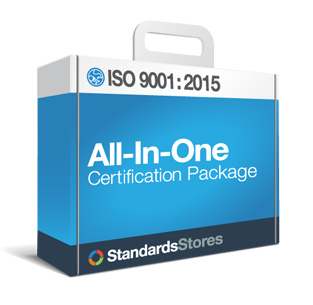Online Web-Based Training
Save Money, Save Time! Train on the Web.
Having difficulty getting your team together for training? Our professional courses are the answer! We offer 20+ courses to help you improve quality and personnel. Web-based training is an excellent alternative if you need scheduling flexibility, want access to all of our courses, and wish to train at multiple locations.
- Web-based training is delivered online via the internet.
- These courses require an internet connection
- Course is purchased and licensed for each user by the course.
- Can be accessed 24/7/365 from anywhere in the world.
- 5 Core Tools package
- 5S’s – Introduction
- 5S Workplace Organization
- 8D Problem-Solving
- A3 for Support Processes Training
- Advanced Control Charts
- Advanced Process Capability
- AIAG-VDA FMEAs – Introduction
- AIAG-VDA FMEA-MSRs
- AIAG-VDA Process-FMEAs
- AIAG-VDA Design-FMEAs
- APQP Advanced Product Quality Planning
- APQP Overview
- Control Charts – Advanced
- Control Chart Basics
- Control Plans
- Cost of Quality
- Cost of Quality – Introduction
- DMAIC – The Basics
- DOE: Screening Experiments
- Error-Proofing Support Processes
- Five Whys
- FMEA – Support Processes Training
- FMEA – Design FMEA
- FMEA – Introduction to FMEAs
- FMEA – Process FMEA
- Gage Training
- GD&T Basics
- IATF Internal Auditing
- Internal Auditing
- Lean for Support
- Lean Implementation
- Lean for Job Shops
- Lean Manufacturing
- Lean Mindset
- Lean – Overview
- Lean Process Layouts
- Overview of Lean Support Processes
- Lean/6 Sigma – Introduction to Lean Six Sigma
- Lean/6 Sigma – The Role of a Lean Six Sigma Champion
- LPA Basics
- Managing Calibration Programs
- Mapping Office Workflows
- Mapping Value Stream
- Measurement System Analysis – MSA
- Measurement System Analysis – MSA Introduction
- Mistake-Proofing – Introduction
- Mistake-Proofing Training!
- PPAP – Production Part Approval Process
- Process Capability – Advanced
- Process Capability – Basics
- Quality Improvement Fundamentals
- Risk-Based Thinking
- Root Cause Analysis
- Root Cause Analysis Overview
- Set-Up Reduction Basics
- SPC – Basic Support Processes Training
- SPC – Basic Training
- TPM Basics – Total Productive Maintenance
- Variation – Understanding
- Visual Workplace Basics
Course length:
- Varies 2 to 20+ hours
- Review specific details for each course you are interested in.
Each Course Includes:
- Reference Guide PDF
- Audio & Video
- Printable certificate for each completion
Features of All Courses:
• Easy reporting for ISO records.
• Powerful learning management and administration.
• Media-rich presentation enhances the training.
• Exercises reinforce concepts and keep learners engaged.
• Printable PDF Reference Guide for future use.
• Solid technical content developed by experts.
• Learners progress through the training at their own pace.
• Bookmarking so learners can start and stop the training as time allows.
• Certificate of Completion that can be easily printed or saved.
• CEUs awarded to fulfill continuing education requirements.
- $99 for 1-month access
- $59 for a 1-month extension BUY NOW!
| Price (Ea) | Min. #Credits |
Courses Active for: | |
|---|---|---|---|
| Small Workgroup | $89 | 10 | 12 Months |
| Large Workgroup | $79 | 50 | 12 Months |
| Corporate Subscription | $69 | 200 | 12 Months |
All Workgroups include learner management in our LMS, which can be integrated to your LMS for seamless course launch.
Online Quality Training Subscription and Volume Pricing Options
Contact Us for Details
Courses
5 Core Tools package (APQP, FMEA, MSA, PPAP, & SPC)
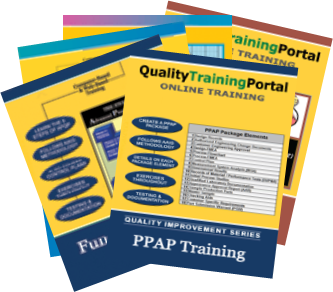 Purchase the Core Tools package (APQP, FMEA, MSA, SPC, & PPAP) and receive 90 Days of access to the online training portal. $455.00
Purchase the Core Tools package (APQP, FMEA, MSA, SPC, & PPAP) and receive 90 Days of access to the online training portal. $455.00
AIAG-VDA FMEA-MSRs
See Course Objectives | See Course Outline 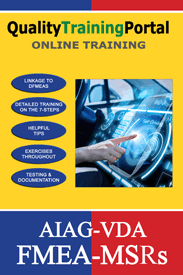 This online training prepares learners to participate on the core team of a Supplemental FMEA for Monitoring and System Response (FMEA-MSR) using the 2019 AIAG-VDA FMEA Handbook. The course provides a background understanding of FMEAs, provides detailed instruction for participating on an FMEA-MSR Core Team and shows how DFMEAs and FMEA-MSRs are linked.
This online training prepares learners to participate on the core team of a Supplemental FMEA for Monitoring and System Response (FMEA-MSR) using the 2019 AIAG-VDA FMEA Handbook. The course provides a background understanding of FMEAs, provides detailed instruction for participating on an FMEA-MSR Core Team and shows how DFMEAs and FMEA-MSRs are linked.
DOE: Screening Experiments
View Demo | See Course Objectives | See Course Outline 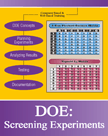 This course provides an introduction to the concepts of Design of Experiments along with detailed instruction on how to conduct screening experiments using Placket-Burman and Taguchi techniques.
This course provides an introduction to the concepts of Design of Experiments along with detailed instruction on how to conduct screening experiments using Placket-Burman and Taguchi techniques.
Basic SPC Training
View Demo | See Course Objectives | See Course Outline 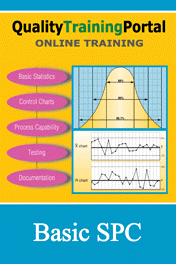 Basic SPC Training provides a solid understanding of variation and the statistics upon which control charts are based. It covers the use of the most common variable and attributes control charts including x-bar & R-charts, moving average charts, p-charts, u-charts, np charts, and c charts as well as basic process capability concepts.
Basic SPC Training provides a solid understanding of variation and the statistics upon which control charts are based. It covers the use of the most common variable and attributes control charts including x-bar & R-charts, moving average charts, p-charts, u-charts, np charts, and c charts as well as basic process capability concepts.
Basic SPC for Support Processes Training
View Demo | See Course Objectives | See Course Outline 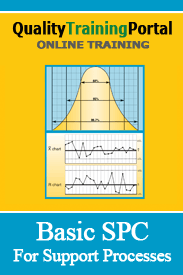 Statistical Process Control (SPC) training can be time-consuming and frustrating because of the complex nature of the statistics underlying SPC control charts. Basic SPC for Support Processes is a comprehensive online training course for service/office professionals and technicians that makes understanding and applying statistical process control concepts easy.
Statistical Process Control (SPC) training can be time-consuming and frustrating because of the complex nature of the statistics underlying SPC control charts. Basic SPC for Support Processes is a comprehensive online training course for service/office professionals and technicians that makes understanding and applying statistical process control concepts easy.
Advanced Control Charts
See Course Objectives | See Course Outline 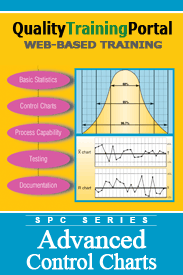 Selecting and setting up the right type of SPC control chart for a given process is crucial to getting the most benefit from statistical process control. With Advanced Control Charts online training, your in-house experts will be able to apply advanced statistical techniques and concepts throughout your operations. Training topics include selecting and setting up SPC Control charts, determining the best control chart format to use for a given process, identifying different patterns of instability, and knowing what they tell you about a process.
Selecting and setting up the right type of SPC control chart for a given process is crucial to getting the most benefit from statistical process control. With Advanced Control Charts online training, your in-house experts will be able to apply advanced statistical techniques and concepts throughout your operations. Training topics include selecting and setting up SPC Control charts, determining the best control chart format to use for a given process, identifying different patterns of instability, and knowing what they tell you about a process.
Advanced Process Capability
See Course Objectives | See Course Outline 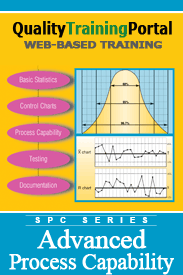 This course covers how to conduct a process capability study, take action to improve capability and deal with complications in interpreting and analyzing capability measures.
This course covers how to conduct a process capability study, take action to improve capability and deal with complications in interpreting and analyzing capability measures.
The 5S’s: Workplace Organization
View Demo | See Course Objectives | See Course Outline 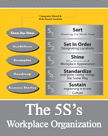 The 5S’s course introduces concepts of workplace organization and walks learners through each of the stages of the 5S process (Sort, Set in Order, Shine, Standardize and Sustain) so that they can apply the techniques in their job and work area. The course includes a roadmap for implementing the 5S’s along with examples of successes in each 5S stage to help trigger ideas for the learner for their 5S effort.
The 5S’s course introduces concepts of workplace organization and walks learners through each of the stages of the 5S process (Sort, Set in Order, Shine, Standardize and Sustain) so that they can apply the techniques in their job and work area. The course includes a roadmap for implementing the 5S’s along with examples of successes in each 5S stage to help trigger ideas for the learner for their 5S effort.
Lean Manufacturing
View Demo | See Course Objectives | See Course Outline 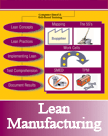 This course provides learners with a comprehensive understanding of how Lean Manufacturing works in a manufacturing company. Lean concepts (why lean, lean terminology, identifying wastes, Value Stream Mapping methods and the linkage between lean and Six Sigma) and lean practices (streamlining the value stream, workplace organization, ensuring predictability and consistency, set-up reduction, TPM, the visual workplace and continuous improvement) are covered. The course provides the learner with lean implementation suggestions including approaches for addressing people issues, collecting, and analyzing data to plan and track lean efforts, process workflow and layouts options with rationale and a sequential roadmap.
This course provides learners with a comprehensive understanding of how Lean Manufacturing works in a manufacturing company. Lean concepts (why lean, lean terminology, identifying wastes, Value Stream Mapping methods and the linkage between lean and Six Sigma) and lean practices (streamlining the value stream, workplace organization, ensuring predictability and consistency, set-up reduction, TPM, the visual workplace and continuous improvement) are covered. The course provides the learner with lean implementation suggestions including approaches for addressing people issues, collecting, and analyzing data to plan and track lean efforts, process workflow and layouts options with rationale and a sequential roadmap.
Lean for Support Processes
View Demo | See Course Objectives | See Course Outline 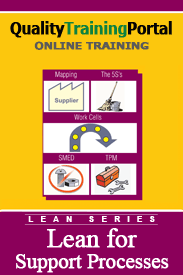 This course provides learners with a comprehensive understanding of how Lean Manufacturing works in a transaction or non-manufacturing business. Lean concepts (why lean, lean terminology, identifying wastes, Value Stream Mapping methods and the linkage between lean and Six Sigma) and lean practices (streamlining the value stream, workplace organization, ensuring predictability and consistency, the visual workplace and continuous improvement) are covered. The course provides the learner with lean implementation suggestions including approaches for addressing people issues, collecting, and analyzing data to plan and track lean efforts, process workflow and layouts options with rationale and a sequential roadmap.
This course provides learners with a comprehensive understanding of how Lean Manufacturing works in a transaction or non-manufacturing business. Lean concepts (why lean, lean terminology, identifying wastes, Value Stream Mapping methods and the linkage between lean and Six Sigma) and lean practices (streamlining the value stream, workplace organization, ensuring predictability and consistency, the visual workplace and continuous improvement) are covered. The course provides the learner with lean implementation suggestions including approaches for addressing people issues, collecting, and analyzing data to plan and track lean efforts, process workflow and layouts options with rationale and a sequential roadmap.
Introduction to Lean Six Sigma
See Course Objectives | See Course Outline 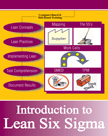 This course introduces learners to the fundamentals of lean and Six Sigma as complementary, additive methodologies that focus on both waste and variation reduction. An overview of the supporting infrastructure needed to sustain the effort is covered as well as examples of Lean Six Sigma application in manufacturing, the office, order entry, warehousing and distribution, sales, and R&D.
This course introduces learners to the fundamentals of lean and Six Sigma as complementary, additive methodologies that focus on both waste and variation reduction. An overview of the supporting infrastructure needed to sustain the effort is covered as well as examples of Lean Six Sigma application in manufacturing, the office, order entry, warehousing and distribution, sales, and R&D.
A3 for Support Processes Training
See Course Objectives | See Course Outline 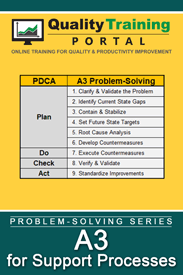 This training will equip A3 problem-solving team members with the tools and process to solve problems using the A3 approach. Similar to most problem-solving models, A3 Problem-Solving is based on the Plan-Do-Check-Act cycle. In addition to detailed instruction on each of the nine steps of the A3 process, learners follow an actual A3 project throughout the course of the training. This helps bring the concepts to life and enables participants to see how the tools, techniques and process will work with their own projects. Upon successful completion of this training, participants will be ready to work on A3 problem-solving teams. This training is specifically focused on non-manufacturing examples throughout the course, so it is perfect for people who work in support processes such as accounting, human resources, purchasing, etc.
This training will equip A3 problem-solving team members with the tools and process to solve problems using the A3 approach. Similar to most problem-solving models, A3 Problem-Solving is based on the Plan-Do-Check-Act cycle. In addition to detailed instruction on each of the nine steps of the A3 process, learners follow an actual A3 project throughout the course of the training. This helps bring the concepts to life and enables participants to see how the tools, techniques and process will work with their own projects. Upon successful completion of this training, participants will be ready to work on A3 problem-solving teams. This training is specifically focused on non-manufacturing examples throughout the course, so it is perfect for people who work in support processes such as accounting, human resources, purchasing, etc.
Mapping Office Workflows
See Course Objectives | See Course Outline 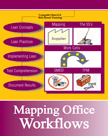 Mapping Office Workflows helps office workers create visual representations of processes that they work in and provides them with tools that help unveil different aspects of their workflow and see the processes they work in from different angles. By using one or more of the mapping tools covered (Brown-Paper Flow, Workflow Diagrams, Flowcharting, Value-Stream Mapping), learners will be able to identify the causes of nagging problems and take action to remedy them.
Mapping Office Workflows helps office workers create visual representations of processes that they work in and provides them with tools that help unveil different aspects of their workflow and see the processes they work in from different angles. By using one or more of the mapping tools covered (Brown-Paper Flow, Workflow Diagrams, Flowcharting, Value-Stream Mapping), learners will be able to identify the causes of nagging problems and take action to remedy them.
Introduction to AIAG-VDA FMEAs
See Course Objectives | See Course Outline 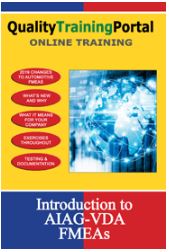 This online training introduces learners to the 2019 AIAG-VDA FMEA Process. Participants will complete the course with an understanding of the new FMEA methodology including the 7-step FMEA process and Action Priority Tables. Failure Mode and Effects Analysis (FMEA) techniques have been used for over 70 (yes, SEVENTY!) years. In recent years, use of FMEAs has gained popularity as a quality improvement tool. Most industries are now using FMEA techniques as part of their risk assessment and risk mitigation strategies.
This online training introduces learners to the 2019 AIAG-VDA FMEA Process. Participants will complete the course with an understanding of the new FMEA methodology including the 7-step FMEA process and Action Priority Tables. Failure Mode and Effects Analysis (FMEA) techniques have been used for over 70 (yes, SEVENTY!) years. In recent years, use of FMEAs has gained popularity as a quality improvement tool. Most industries are now using FMEA techniques as part of their risk assessment and risk mitigation strategies.
AIAG-VDA Process-FMEAs
See Course Objectives | See Course Outline 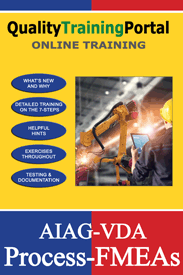 This online training prepares learners to participate on the core team of a Process-FMEA (PFMEA) using the 2019 AIAG-VDA FMEA Process. The course provides a background understanding of FMEAs including their history, detailed instruction on how to use the seven-step FMEA process and highlights tips for getting the most out of PFMEAs. Most industries are now using FMEA techniques as part of their risk assessment and risk mitigation strategies. Unlike many quality improvement tools, FMEAs do not require complicated statistics yet they can yield significant savings for a company as well as reduce potential risks and associated liabilities of a product or process that does not perform as intended.
This online training prepares learners to participate on the core team of a Process-FMEA (PFMEA) using the 2019 AIAG-VDA FMEA Process. The course provides a background understanding of FMEAs including their history, detailed instruction on how to use the seven-step FMEA process and highlights tips for getting the most out of PFMEAs. Most industries are now using FMEA techniques as part of their risk assessment and risk mitigation strategies. Unlike many quality improvement tools, FMEAs do not require complicated statistics yet they can yield significant savings for a company as well as reduce potential risks and associated liabilities of a product or process that does not perform as intended.
AIAG-VDA Design-FMEAs
See Course Objectives | See Course Outline 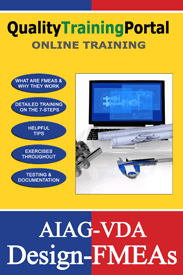 This online training prepares learners to participate on the core team of a Design-FMEA (DFMEA) using the 2019 AIAG-VDA FMEA Process. The course provides a background understanding of FMEAs, provides detailed instruction for participating on a DFMEA Core Team and conceptually introduces FMEAs for Monitoring and System Response (FMEA-MSR). Most industries are now using FMEA techniques as part of their risk assessment and risk mitigation strategies. Unlike many quality improvement tools, FMEAs do not require complicated statistics. FMEA studies can yield significant savings for a company as well as reduce potential risks and associated liabilities of a product or process that does not perform as intended.
This online training prepares learners to participate on the core team of a Design-FMEA (DFMEA) using the 2019 AIAG-VDA FMEA Process. The course provides a background understanding of FMEAs, provides detailed instruction for participating on a DFMEA Core Team and conceptually introduces FMEAs for Monitoring and System Response (FMEA-MSR). Most industries are now using FMEA techniques as part of their risk assessment and risk mitigation strategies. Unlike many quality improvement tools, FMEAs do not require complicated statistics. FMEA studies can yield significant savings for a company as well as reduce potential risks and associated liabilities of a product or process that does not perform as intended.
FMEA For Support Processes
View Demo | See Course Objectives | See Course Outline 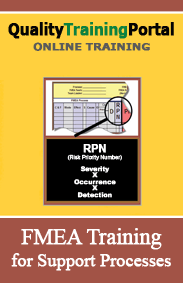 FMEA Training provides step-by-step instructions on how to conduct Process-FMEAs (PFMEAs) in a non-manufacturing setting. Learners completing this training will be able to effectively participate on an FMEA team and make immediate contributions to quality and productivity improvement efforts.
FMEA Training provides step-by-step instructions on how to conduct Process-FMEAs (PFMEAs) in a non-manufacturing setting. Learners completing this training will be able to effectively participate on an FMEA team and make immediate contributions to quality and productivity improvement efforts.
Mistake-Proofing Training!
View Demo | See Course Objectives | See Course Outline 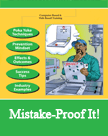 This course arms learners with a comprehensive background on mistake-proofing techniques focusing on problem prevention rather than problem detection/correction. Practical tools to design and implement mistake-proofing solutions are presented. The course includes approximately 150 examples of mistake-proofed solutions to provide learners with visual and mental triggers to mistake-proof their own processes.
This course arms learners with a comprehensive background on mistake-proofing techniques focusing on problem prevention rather than problem detection/correction. Practical tools to design and implement mistake-proofing solutions are presented. The course includes approximately 150 examples of mistake-proofed solutions to provide learners with visual and mental triggers to mistake-proof their own processes.
Error-Proofing Support Processes
View Demo | See Course Objectives | See Course Outline 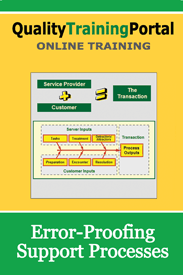 Error-Proofing Support Processes is designed specifically for those working in offices and transactional environments. This course explores how to error-proof transactional processes by studying both the server-side (service provider) and the customer-side of the transaction. The course provides learners with techniques to uncover the root cause of errors and then prevent their recurrence.
Error-Proofing Support Processes is designed specifically for those working in offices and transactional environments. This course explores how to error-proof transactional processes by studying both the server-side (service provider) and the customer-side of the transaction. The course provides learners with techniques to uncover the root cause of errors and then prevent their recurrence.
Gage Training
View Demo | See Course Objectives | See Course Outline  Gage Training is metrology, gage and GD&T training designed for operators and technicians who use dimensional gages in their jobs. Learners are introduced to basic dimensional metrology concepts including an introduction to geometric dimensioning and tolerancing (GD&T) and the fundamentals of surface finishes. Gage Training also covers how to take measurements with the most frequently used dimensional instruments including calipers, micrometers, height and depth gages, fixed gages, gage blocks and surface plates and helps learners understand how to avoid common measuring mistakes.
Gage Training is metrology, gage and GD&T training designed for operators and technicians who use dimensional gages in their jobs. Learners are introduced to basic dimensional metrology concepts including an introduction to geometric dimensioning and tolerancing (GD&T) and the fundamentals of surface finishes. Gage Training also covers how to take measurements with the most frequently used dimensional instruments including calipers, micrometers, height and depth gages, fixed gages, gage blocks and surface plates and helps learners understand how to avoid common measuring mistakes.
GD&T Basics
See Course Objectives | See Course Outline 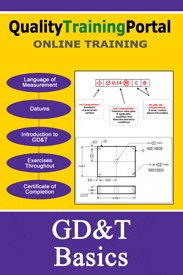 Precision parts require precision measurements and that starts with knowing how to read blueprints and engineering drawings so that the proper measurements can be taken. In this course, learners will be introduced to key terms used in metrology and GD&T and how to read and interpret basic engineering drawing and GD&T symbols.
Precision parts require precision measurements and that starts with knowing how to read blueprints and engineering drawings so that the proper measurements can be taken. In this course, learners will be introduced to key terms used in metrology and GD&T and how to read and interpret basic engineering drawing and GD&T symbols.
Managing Calibration Programs
See Course Objectives | See Course Outline 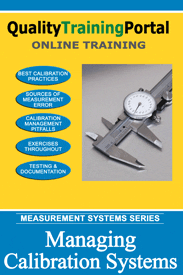 The Managing Calibration Programs course will help learners learn about the importance of measurement device calibration management.
The Managing Calibration Programs course will help learners learn about the importance of measurement device calibration management.
Measurement System Analysis
See Course Objectives | See Course Outline 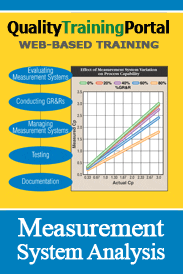 MSA (Measurement Systems Analysis) online training includes detailed tutorials on many measurement system analysis techniques including how to conduct and analyze GR&R (Gage Repeatability and Reproducibility) Studies. A GR&R is the accepted technique for evaluating the level of variation in a measurement system and determining if the measurement system is acceptable for use. Measurement System Analysis covers techniques for analyzing the variation within a measurement system, determining its suitability for use, and ways to improve measurement systems. The GR&R analysis techniques used in the MSA online training program are in compliance with IATF 16949/AIAG methods.
MSA (Measurement Systems Analysis) online training includes detailed tutorials on many measurement system analysis techniques including how to conduct and analyze GR&R (Gage Repeatability and Reproducibility) Studies. A GR&R is the accepted technique for evaluating the level of variation in a measurement system and determining if the measurement system is acceptable for use. Measurement System Analysis covers techniques for analyzing the variation within a measurement system, determining its suitability for use, and ways to improve measurement systems. The GR&R analysis techniques used in the MSA online training program are in compliance with IATF 16949/AIAG methods.
Introduction to MSA
See Course Objectives | See Course Outline 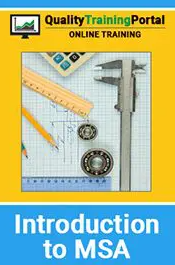 The Introduction to MSA online training course provides learners with a basic introduction to measurement system analysis (MSA), why it is important, the techniques used to analyze the variation within a measurement system, what MSA results mean, and ways to improve measurement systems. This course provides learners with a basic introduction to measurement system analysis (MSA), why it is important, the techniques used to analyze the variation within a measurement system, what MSA results mean, and ways to improve measurement systems conceptually without needing to learn the corresponding formulas and math.
The Introduction to MSA online training course provides learners with a basic introduction to measurement system analysis (MSA), why it is important, the techniques used to analyze the variation within a measurement system, what MSA results mean, and ways to improve measurement systems. This course provides learners with a basic introduction to measurement system analysis (MSA), why it is important, the techniques used to analyze the variation within a measurement system, what MSA results mean, and ways to improve measurement systems conceptually without needing to learn the corresponding formulas and math.
Quality Improvement Fundamentals
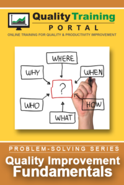 See Course Objectives | See Course Outline Quality Improvement Fundamentals focuses on gathering data and using that data with eight powerful data display tools. The eight tools all use display techniques that literally turn the data into pictures. All processes generate data, and that data can help us better understand our processes so that we can make informed decisions on how to improve or “fix” them. If we use data display tools, those tools help present the data in the form of a “picture” that provides valuable clues about what is happening with the process and its outcomes.
See Course Objectives | See Course Outline Quality Improvement Fundamentals focuses on gathering data and using that data with eight powerful data display tools. The eight tools all use display techniques that literally turn the data into pictures. All processes generate data, and that data can help us better understand our processes so that we can make informed decisions on how to improve or “fix” them. If we use data display tools, those tools help present the data in the form of a “picture” that provides valuable clues about what is happening with the process and its outcomes.
APQP Advanced Product Quality Planning
See Course Objectives | See Course Outline 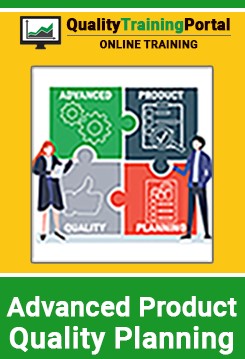 Use the NEW 2024 APQP Guidelines (following the AIAG 3rd Edition Reference Manual) when designing and developing new products.
Use the NEW 2024 APQP Guidelines (following the AIAG 3rd Edition Reference Manual) when designing and developing new products.
Apply quality improvement tools and techniques throughout the APQP process.
Explain how PPAP is used to communicate product quality status to customers.
8D Problem-Solving
View Demo | See Course Objectives | See Course Outline 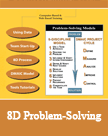 This course teaches learners how to solve problems in a team setting using the 8-D (8-Discipline) problem-solving method. The course includes tutorials on dozens of problem-solving tools that help identify, analyze, and fix problems.
This course teaches learners how to solve problems in a team setting using the 8-D (8-Discipline) problem-solving method. The course includes tutorials on dozens of problem-solving tools that help identify, analyze, and fix problems.
The Basics of DMAIC
View Demo | See Course Objectives | See Course Outline 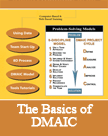 This course is a variation of the “DMAIC Problem-Solving” course. Its strong focus on Value Stream Mapping aligns the course with a Lean Six Sigma approach. The course includes tutorials on many problem-solving tools that help identify, analyze, and fix problems.
This course is a variation of the “DMAIC Problem-Solving” course. Its strong focus on Value Stream Mapping aligns the course with a Lean Six Sigma approach. The course includes tutorials on many problem-solving tools that help identify, analyze, and fix problems.
The Role of a Lean Six Sigma Champion
See Course Objectives | See Course Outline 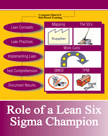 The Role of a Lean Six Sigma Champion course gives champions the knowledge they need to successfully mentor project teams and bridge the gap between black belts and organization management. Participants learn how to keep teams aligned with core business objectives, stay focused and achieve success.
The Role of a Lean Six Sigma Champion course gives champions the knowledge they need to successfully mentor project teams and bridge the gap between black belts and organization management. Participants learn how to keep teams aligned with core business objectives, stay focused and achieve success.
Root Cause Analysis
View Demo | See Course Objectives | See Course Outline 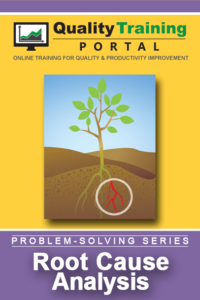 Root Cause Analysis with Corrective Action leads the learner through a four-step process for uncovering and tackling sources of problems and defects so that root causes can be addressed, and the resulting problems eliminated for good.
Root Cause Analysis with Corrective Action leads the learner through a four-step process for uncovering and tackling sources of problems and defects so that root causes can be addressed, and the resulting problems eliminated for good.
IATF Internal Auditing
View Demo |See Course Objectives | See Course Outline 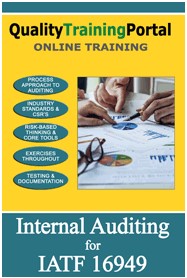 This course, Internal Auditing for IATF 16949, prepares in-house personnel to serve on internal teams auditing against the IATF 16949 standard. Participants not only learn the details of each of the six steps of conducting an internal audit, but specifically how to use a process focus as required by the IATF 16949 standard.
This course, Internal Auditing for IATF 16949, prepares in-house personnel to serve on internal teams auditing against the IATF 16949 standard. Participants not only learn the details of each of the six steps of conducting an internal audit, but specifically how to use a process focus as required by the IATF 16949 standard.
Internal Auditing
View Demo |See Course Objectives | See Course Outline 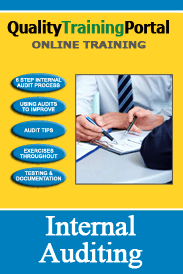 This course, Internal Audit Training, prepares people to serve on internal auditor teams, but it is also valuable training for anyone involved in an internal audit either as an auditor or as someone whose department or process is being audited. The course provides a foundation for conducting internal audits and will assure that all those involved in the audit (those doing the audit and those who’s processes are being audited) have a common understanding of the audit steps, general objectives, and benefits of effective internal audits.
This course, Internal Audit Training, prepares people to serve on internal auditor teams, but it is also valuable training for anyone involved in an internal audit either as an auditor or as someone whose department or process is being audited. The course provides a foundation for conducting internal audits and will assure that all those involved in the audit (those doing the audit and those who’s processes are being audited) have a common understanding of the audit steps, general objectives, and benefits of effective internal audits.
Cost of Quality
See Course Objectives | See Course Outline 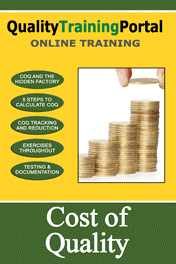 Cost of Quality provides an excellent means to measure and track costs associated with poor quality, quality improvement and quality control. But it requires commitment from a wide range of functions throughout an organization. These groups need to have a common understanding of COQ and need to work together to establish meaningful measures.
Cost of Quality provides an excellent means to measure and track costs associated with poor quality, quality improvement and quality control. But it requires commitment from a wide range of functions throughout an organization. These groups need to have a common understanding of COQ and need to work together to establish meaningful measures.
Design-FMEAs
See Course Objectives | See Course Outline 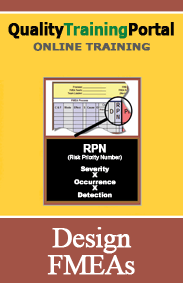 Failure Mode and Effectives Analysis (FMEA) training provides step-by-step instructions on how to conduct a Design-FMEAs (DFMEA). Learners completing this training will be able to effectively participate on a DFMEA team and make immediate contributions to quality and productivity improvement efforts.
Failure Mode and Effectives Analysis (FMEA) training provides step-by-step instructions on how to conduct a Design-FMEAs (DFMEA). Learners completing this training will be able to effectively participate on a DFMEA team and make immediate contributions to quality and productivity improvement efforts.
Five Whys
See Course Objectives | See Course Outline 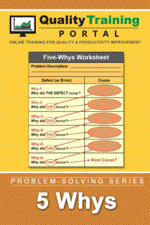 5 Whys training introduces learners to this problem-solving technique including how to formulate “why?” questions and then how to collect and analyze data to properly answer the questions. Examples of the questioning process in a variety of settings are provided and pitfalls to using the process are discussed along with strategies to avoid them. 5 Whys is a problem-solving technique used to get to the root cause of an issue by asking “why?” 5 times (or more).
5 Whys training introduces learners to this problem-solving technique including how to formulate “why?” questions and then how to collect and analyze data to properly answer the questions. Examples of the questioning process in a variety of settings are provided and pitfalls to using the process are discussed along with strategies to avoid them. 5 Whys is a problem-solving technique used to get to the root cause of an issue by asking “why?” 5 times (or more).
Introduction to Cost of Quality
See Course Objectives | See Course Outline 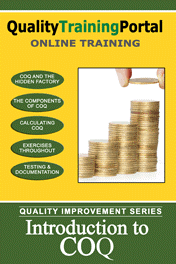 This course will provide leaders, managers, supervisors, and others who use, but are not involved in the day-to-day calculation and maintenance of Cost of Quality Reports with a working knowledge of the basic concepts and language of Cost of Quality.
This course will provide leaders, managers, supervisors, and others who use, but are not involved in the day-to-day calculation and maintenance of Cost of Quality Reports with a working knowledge of the basic concepts and language of Cost of Quality.
Introduction to FMEAs
See Course Objectives | See Course Outline 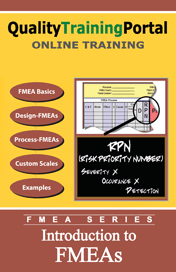 This online training introduces learners to the basic concepts of conducting a Failure Mode and Effects Analysis. It is ideal for managers and supervisors who oversee teams responsible for conducting FMEAs, but who will not be actually serving on the FMEA team.
This online training introduces learners to the basic concepts of conducting a Failure Mode and Effects Analysis. It is ideal for managers and supervisors who oversee teams responsible for conducting FMEAs, but who will not be actually serving on the FMEA team.
Overview of APQP
See Course Objectives | See Course Outline 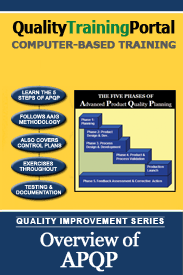 The Overview of APQP training is ideal for managers and supervisors who oversee departments responsible for Advanced Product Quality Planning. This is a short online course intended to explain the basic approach and scope of the Advanced Product and Quality Planning (APQP) methodology.
The Overview of APQP training is ideal for managers and supervisors who oversee departments responsible for Advanced Product Quality Planning. This is a short online course intended to explain the basic approach and scope of the Advanced Product and Quality Planning (APQP) methodology.
Overview of Root Cause Analysis
See Course Objectives | See Course Outline 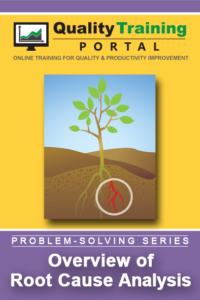 Overview of Root Cause Analysis online training provides the learner with a basic understanding of the principles and techniques of Root Cause Analysis and Corrective Action. The course is ideal for managers and supervisors who need to understand the terminology and process of RCA without needing to know the specific “how to” details.
Overview of Root Cause Analysis online training provides the learner with a basic understanding of the principles and techniques of Root Cause Analysis and Corrective Action. The course is ideal for managers and supervisors who need to understand the terminology and process of RCA without needing to know the specific “how to” details.
Lean for Job Shops
View Demo | See Course Objectives | See Course Outline 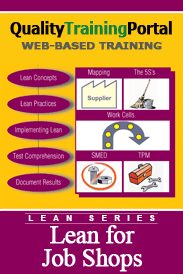 Lean for Job Shops online training is designed specifically to help Job Shops adapt, prioritize, and apply Lean Manufacturing tools and techniques to a Job Shop environment. Participants will learn how to implement Lean Manufacturing practices to complement the realities of their unique job shop environment.
Lean for Job Shops online training is designed specifically to help Job Shops adapt, prioritize, and apply Lean Manufacturing tools and techniques to a Job Shop environment. Participants will learn how to implement Lean Manufacturing practices to complement the realities of their unique job shop environment.
Process-FMEAs
See Course Objectives | See Course Outline 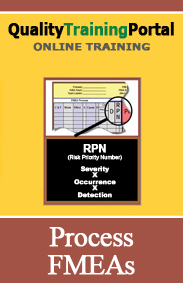 Process FMEA training provides step-by-step instructions on how to conduct a Process FMEAs. Learners completing this training will be able to effectively participate on a PFMEA team and make immediate contributions to quality and productivity improvement efforts.
Process FMEA training provides step-by-step instructions on how to conduct a Process FMEAs. Learners completing this training will be able to effectively participate on a PFMEA team and make immediate contributions to quality and productivity improvement efforts.
Risk-Based Thinking
View Demo | See Course Objectives | See Course Outline 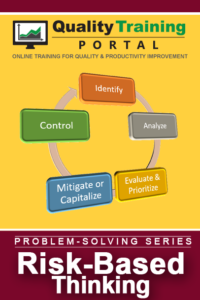 Both industry-wide and industry-specific standards have incorporated risk-based thinking into their requirements. Some standards call for assessing risk levels and taking action to deal with risks that are identified, others call for organizations to define risk management protocols. But, in all cases, the underlying premise of risk-based thinking is that organizations should always factor in risks as they develop plans, review business results, and take corrective action. The intent is for the organization to identify the risk, decide what (if any) action is required and then act.
Both industry-wide and industry-specific standards have incorporated risk-based thinking into their requirements. Some standards call for assessing risk levels and taking action to deal with risks that are identified, others call for organizations to define risk management protocols. But, in all cases, the underlying premise of risk-based thinking is that organizations should always factor in risks as they develop plans, review business results, and take corrective action. The intent is for the organization to identify the risk, decide what (if any) action is required and then act.
Production Part Approval Process
See Course Objectives | See Course Outline 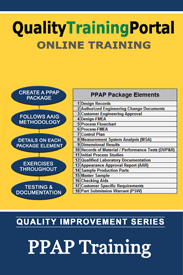 PPAP was developed by AIAG (the Automotive Industry Action Group), and it is an important part of their comprehensive Advanced Product Quality Planning (APQP) approach.
PPAP was developed by AIAG (the Automotive Industry Action Group), and it is an important part of their comprehensive Advanced Product Quality Planning (APQP) approach.
Advanced Control Charts
See Course Objectives | See Course Outline  Control charts are tools that are used to monitor and control variation in processes. Control charts enable operators to determine if the variation in a process is due to expected common causes or if something unexpected has happened to change the expected output. With this information, an operator can then decide whether or not to adjust the process.
Control charts are tools that are used to monitor and control variation in processes. Control charts enable operators to determine if the variation in a process is due to expected common causes or if something unexpected has happened to change the expected output. With this information, an operator can then decide whether or not to adjust the process.
Advanced Process Capability
See Course Objectives | See Course Outline 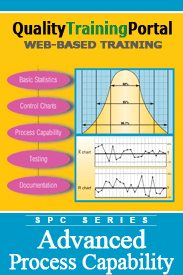 Process Capability Study is a tool used to determine if a stable process is capable of meeting a customer’s specification. Process capability is based on statistical techniques that are used to predict the complete output of a process based on a relatively small sample. There are different ways to measure process capability including the capability ratio, capability index and the Cpk. The Cpk is the most commonly used measure of process capability because it not only determines if the process is capable is meeting the spec, but it also predicts how well the process is centered on the nominal of the specification.
Process Capability Study is a tool used to determine if a stable process is capable of meeting a customer’s specification. Process capability is based on statistical techniques that are used to predict the complete output of a process based on a relatively small sample. There are different ways to measure process capability including the capability ratio, capability index and the Cpk. The Cpk is the most commonly used measure of process capability because it not only determines if the process is capable is meeting the spec, but it also predicts how well the process is centered on the nominal of the specification.
Control Chart Basics
See Course Objectives | See Course Outline 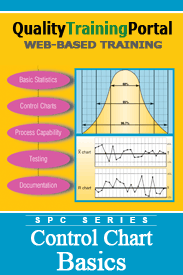 Control charts are tools that are used to monitor and control variation in processes. Control charts enable operators to determine if the variation in a process is due to expected common causes or if something unexpected has happened to change the expected output. With this information, an operator can then decide whether or not to adjust the process.
Control charts are tools that are used to monitor and control variation in processes. Control charts enable operators to determine if the variation in a process is due to expected common causes or if something unexpected has happened to change the expected output. With this information, an operator can then decide whether or not to adjust the process.
Control Plans
See Course Objectives | See Course Outline 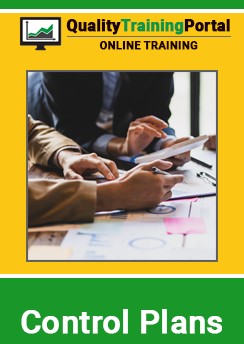 Use the NEW 2024 Control Plans Guidelines (following the AIAG Reference Manual) to ensure products and the processes that create them, meet customer requirements. Minimize process and product variation by assuring all process outputs are in a state of control at every step of the product and process life cycle. Develop a control plan that summarizes the key product, process, and special characteristics, the associated methods used to measure and monitor output and the action plan including who is accountable.
Use the NEW 2024 Control Plans Guidelines (following the AIAG Reference Manual) to ensure products and the processes that create them, meet customer requirements. Minimize process and product variation by assuring all process outputs are in a state of control at every step of the product and process life cycle. Develop a control plan that summarizes the key product, process, and special characteristics, the associated methods used to measure and monitor output and the action plan including who is accountable.
Introduction to Mistake-Proofing
See Course Objectives | See Course Outline 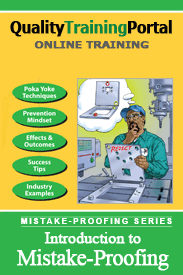 Introduction to Mistake-Proofing is an online training course designed to introduce learners to the prevention-focused mindset that is the cornerstone of mistake-proofing. Learners will also become familiar with mistake-proofing concepts, tools and techniques used to formulate (and evaluate) mistake-proofing solutions.
Introduction to Mistake-Proofing is an online training course designed to introduce learners to the prevention-focused mindset that is the cornerstone of mistake-proofing. Learners will also become familiar with mistake-proofing concepts, tools and techniques used to formulate (and evaluate) mistake-proofing solutions.
LPA Basics for Layer 1 Auditors Training
See Course Objectives | See Course Outline 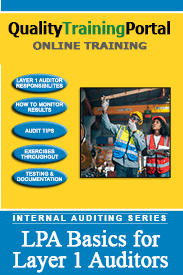 LPA Basics for Layer 1 Auditors training prepares learners to conduct Layer 1 audits in organizations using Layered Process Audits. Participants will learn what a Layered Process Audit is and the benefits it brings to an organization. They will also be introduced to the 10-step approach to planning, developing and rolling out LPAs, what their responsibilities are as a Layer 1 Auditor and how to monitor results, track progress and make suggestions to improve the LPA Program.
LPA Basics for Layer 1 Auditors training prepares learners to conduct Layer 1 audits in organizations using Layered Process Audits. Participants will learn what a Layered Process Audit is and the benefits it brings to an organization. They will also be introduced to the 10-step approach to planning, developing and rolling out LPAs, what their responsibilities are as a Layer 1 Auditor and how to monitor results, track progress and make suggestions to improve the LPA Program.
Introduction to the 5S’s
See Course Objectives | See Course Outline 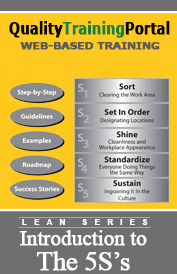 The Introduction to the 5S’s online training program consists of two lessons and a challenge. Lesson 1, What is 5S All About? Takes the learner through each of the 5S’s (Sort, Set in Order, Shine, Standardize, and Sustain.). In Lesson 2, An Organization-Wide 5S Effort. A roadmap for implementing the 5S’s is presented. The Challenge tests the learner’s knowledge of the subject matter.
The Introduction to the 5S’s online training program consists of two lessons and a challenge. Lesson 1, What is 5S All About? Takes the learner through each of the 5S’s (Sort, Set in Order, Shine, Standardize, and Sustain.). In Lesson 2, An Organization-Wide 5S Effort. A roadmap for implementing the 5S’s is presented. The Challenge tests the learner’s knowledge of the subject matter.
Lean Implementation
See Course Objectives | See Course Outline 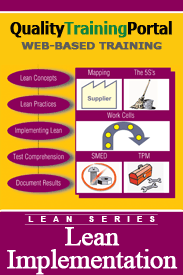 This course introduces leaders and managers to a step-by-step implementation plan and roadmap for implementing Lean. Simply put, lean organizations are customer focused. They reduce waste in their value streams by improving workflows and then by subsequently improving the physical layout of their facilities.
This course introduces leaders and managers to a step-by-step implementation plan and roadmap for implementing Lean. Simply put, lean organizations are customer focused. They reduce waste in their value streams by improving workflows and then by subsequently improving the physical layout of their facilities.
Lean Mindset
See Course Objectives | See Course Outline 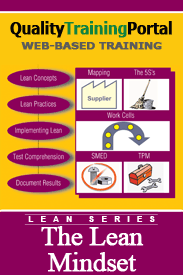 This course explores the mindset needed to launch and sustain a successful Lean initiative. The most productive lean efforts extend beyond manufacturing to the entire organization; it is everyone’s job to drive waste out of the organization.
This course explores the mindset needed to launch and sustain a successful Lean initiative. The most productive lean efforts extend beyond manufacturing to the entire organization; it is everyone’s job to drive waste out of the organization.
Lean Process Layouts
See Course Objectives | See Course Outline 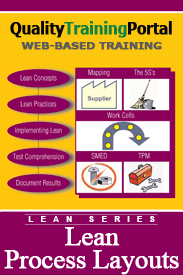 This course explores sources and formats for collecting and analyzing data for lean efforts and shows how to use that data to design process flow patterns and physical layout options leading to lean practices. Manufacturing process layouts are an important focus in Lean organizations because they are often full of inefficiencies that lead to wasted time, effort, and materials.
This course explores sources and formats for collecting and analyzing data for lean efforts and shows how to use that data to design process flow patterns and physical layout options leading to lean practices. Manufacturing process layouts are an important focus in Lean organizations because they are often full of inefficiencies that lead to wasted time, effort, and materials.
Lean Support Processes
See Course Objectives | See Course Outline  This course will help employees who support manufacturing operations understand how Lean Manufacturing will impact their functions and responsibilities. Each key function purchasing, scheduling, accounting, and shipping/warehousing is presented in terms of how its role needs to change to support lean manufacturing as well as how waste needs to be driven out of the supporting process itself.
This course will help employees who support manufacturing operations understand how Lean Manufacturing will impact their functions and responsibilities. Each key function purchasing, scheduling, accounting, and shipping/warehousing is presented in terms of how its role needs to change to support lean manufacturing as well as how waste needs to be driven out of the supporting process itself.
Overview of Lean
See Course Objectives | See Course Outline 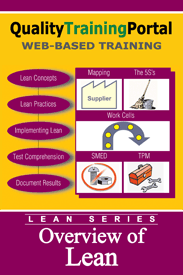 This course provides an overview of the principles and practices of Lean. It is a great starting point for organizations to introduce managers and employees to the concepts and benefits of Lean Manufacturing. Simply put, lean organizations are customer focused. They reduce waste in their value streams by improving workflows and then by subsequently improving the physical layout of their facilities.
This course provides an overview of the principles and practices of Lean. It is a great starting point for organizations to introduce managers and employees to the concepts and benefits of Lean Manufacturing. Simply put, lean organizations are customer focused. They reduce waste in their value streams by improving workflows and then by subsequently improving the physical layout of their facilities.
Process Capability Basics
See Course Objectives | See Course Outline 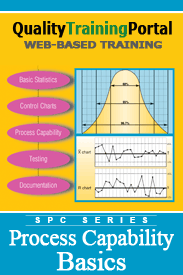 This course provides a basic understanding of what process capability is and how it is statistically measured. Process Capability Ratio (Cr) and Process Capability Index (Cp) are covered to help understand the basic concept of process capability and then Cpk is explained and presented as a better measure of true process capability.
This course provides a basic understanding of what process capability is and how it is statistically measured. Process Capability Ratio (Cr) and Process Capability Index (Cp) are covered to help understand the basic concept of process capability and then Cpk is explained and presented as a better measure of true process capability.
Set-Up Reduction Basics
See Course Objectives | See Course Outline 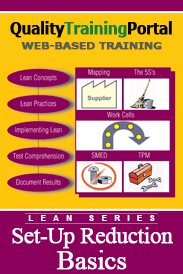 Set-Up Reduction Basics introduces learners to the importance of quick equipment changeover and teaches the basic tools to reduce set-up time. Perhaps one of the most important yet underappreciated aspects of lean is reducing the time to set-up or changeover processes from one product to another. Whenever process equipment is being “set-up” or “changed-over” to make the next part, it is not productive, and “waste” is incurred. Reducing set-up time converts time equipment is shutdown being reconfigured to make another product into productive time.
Set-Up Reduction Basics introduces learners to the importance of quick equipment changeover and teaches the basic tools to reduce set-up time. Perhaps one of the most important yet underappreciated aspects of lean is reducing the time to set-up or changeover processes from one product to another. Whenever process equipment is being “set-up” or “changed-over” to make the next part, it is not productive, and “waste” is incurred. Reducing set-up time converts time equipment is shutdown being reconfigured to make another product into productive time.
TPM Basics
See Course Objectives | See Course Outline 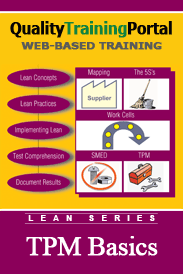 TPM Basics teaches learners the importance of equipment up-time in a Lean Manufacturing environment and introduces Total Productive Maintenance tools and techniques along with a three-phase implementation process. Lean organizations strive to reduce waste in all phases of the operation. Some of the least understood and most overlooked sources of waste relate to the condition and maintenance of processing equipment. One premise of Lean Manufacturing is that equipment is ready to run whenever it is needed (to meet customer demands).
TPM Basics teaches learners the importance of equipment up-time in a Lean Manufacturing environment and introduces Total Productive Maintenance tools and techniques along with a three-phase implementation process. Lean organizations strive to reduce waste in all phases of the operation. Some of the least understood and most overlooked sources of waste relate to the condition and maintenance of processing equipment. One premise of Lean Manufacturing is that equipment is ready to run whenever it is needed (to meet customer demands).
Understanding Variation
See Course Objectives | See Course Outline 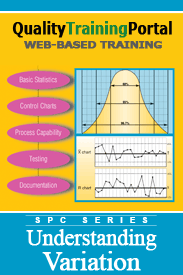 This course is a primer in the statistics used for SPC (Statistical Process Control); topics covered include building and using a histogram to understand variation, patterns of variation, measures of variation (mean, range, standard deviation), the normal curve and process stability. Both graphical and mathematical techniques of measuring variation are covered. This course is a targeted training course and provides focused training on concepts of variation that serve as the foundation of control charts.
This course is a primer in the statistics used for SPC (Statistical Process Control); topics covered include building and using a histogram to understand variation, patterns of variation, measures of variation (mean, range, standard deviation), the normal curve and process stability. Both graphical and mathematical techniques of measuring variation are covered. This course is a targeted training course and provides focused training on concepts of variation that serve as the foundation of control charts.
Value Stream Mapping
See Course Objectives | See Course Outline 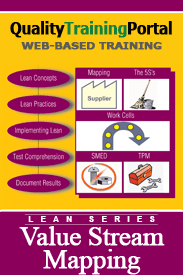 In this targeted online training, learners will gain an understanding of the purpose of conducting a value stream analysis and what a value stream map is. Steps to streamline a value stream from current state to future state are presented. A value stream is another term for a process that has inputs, performs work on those inputs, and generates an output that has added value. The basic premise of a value stream is that value is added as goods or services stream through the process.
In this targeted online training, learners will gain an understanding of the purpose of conducting a value stream analysis and what a value stream map is. Steps to streamline a value stream from current state to future state are presented. A value stream is another term for a process that has inputs, performs work on those inputs, and generates an output that has added value. The basic premise of a value stream is that value is added as goods or services stream through the process.
Visual Workplace Basics
See Course Objectives | See Course Outline 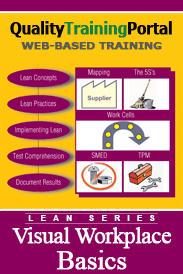 Visual Workplace Basics introduces learners to the concept of visual controls, prompts and displays as tools that can make work easier and reduce errors. When an organization commits to create a Visual Workplace, they are committing to exploring ways that make it easier for people to get their work done effectively and efficiently. Most Visual Workplace techniques involve the use of relatively “low-tech” common-sense modifications to work practices.
Visual Workplace Basics introduces learners to the concept of visual controls, prompts and displays as tools that can make work easier and reduce errors. When an organization commits to create a Visual Workplace, they are committing to exploring ways that make it easier for people to get their work done effectively and efficiently. Most Visual Workplace techniques involve the use of relatively “low-tech” common-sense modifications to work practices.



